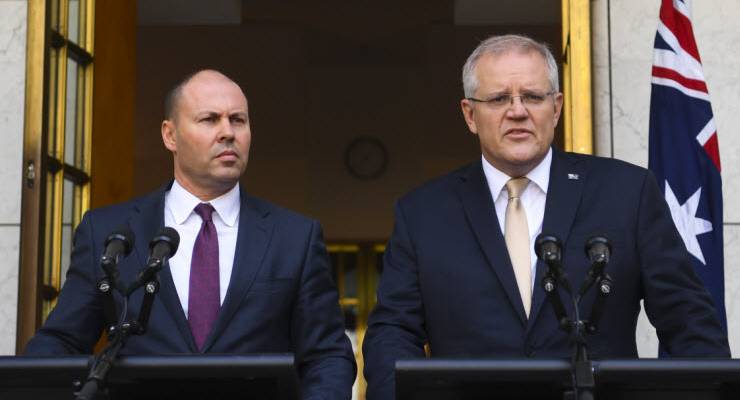
In raining at least $90 billion on the financial system to encourage banks to keep lending, the Reserve Bank has indicated not merely that the economy faces an unprecedented — if temporary — slump, but that the effects will linger for years. Specifically, at least three years.
Yesterday, RBA governor Philip Lowe followed up the bank’s announcement of another interest rate cut, a government bond-buying program and a minimum $90 billion funding mechanism with a rare media conference intended to complement the Morrison government’s response.
Both Lowe and Morrison (who, inexplicably, called a media conference 15 minutes before Lowe’s long-awaited speech) made much of the “bridge” metaphor — a bridge of cash to get us to the other side of, hopefully, late 2020 when the virus crisis has passed and Australians start finding jobs again.
Lowe sees the new record low cash rate of 0.25% as lasting for at least three years, and is using that timeframe as a guide to the bank’s overall strategy:
We have chosen the three-year horizon as it influences funding rates across much of the Australian economy and is an important rate in financial markets. It is also consistent with the board’s expectation that the cash rate will remain at its current level for some years, but not forever.
Lowe expects “significant job losses” and a “major hit to the economy” but was unwilling to offer forecasts, given the volatility of the situation. A number of private sector forecasts yesterday for the US and other economies suggested a catastrophic contraction in the June quarter before a strong recovery in the second half of the year.
The RBA’s strategy is to stabilise the financial system, then drive down business interest rates and expand the pool of available funds for business to access at those lower rates to tide them over until the recovery.
In the absence of such measures, banks would start curbing lending as businesses struggled to survive, loan default levels would surge and job losses would mount as businesses closed. This would potentially affect the residential mortgage sector, in turn raising questions about the stability of the major banks.
Importantly, Lowe made it clear there would be no extra funds provided for mortgage lending or to developers. The focus is strictly on business lending to keep Australia’s employers going through the crisis. With interest rates now at 0.25%, the housing market doesn’t need any help.
The government is bolstering the RBA’s effort with $15 billion for small banks and other groups that fund small businesses outside the banking system. Meanwhile, prudential regulator APRA has told the banks they can deploy some of the $235 billion in extra capital buffers they have built up at APRA’s direction in recent years for lending.
Even if banks are willing to lend, however, it still requires businesses to be willing to borrow — and it requires those businesses to be viable.
That’s all the RBA, financial regulators and the banks can do: support business.
They can’t drive customers through the door, they can’t conjure lost sales or replace vanished contracts. And they can’t force customers to spend, or keep workers in jobs.
Business owners may be willing to stick at it through the crisis if they know the financial system and their bank will support them, but the RBA has done its bit now.
Beyond that, it’s up to government. It must support demand, keep people in jobs, keep businesses open. Its next stimulus package — mooted for the next couple of days — has to do what the RBA can’t.
With some forecasters suggesting GDP could fall by 5-10%, the package must be at least as big as the $90 billion funding made available by the RBA. It has to range across demand support — will we finally see a Newstart increase? — wage subsidies and tax relief for business to give the package the greatest possible chance of success.
But others can help, as well. Industry super funds control hundreds of billions of dollars — far more than any other group in the economy. Will they volunteer to help maintain employment and support businesses via their extensive shareholdings in major companies?
Super funds all benefit from a regulated system that forces people to save with them — it may be time to require super funds to pitch in to protect employment (it’s their own members’ jobs at risk, after all). That also applies to the Future Fund and its more than $150 billion in holdings. It’s there ostensibly to provide benefits to public servants (and to make the government’s accounts look pretty), but it can also be a source of investment.
And what about allowing members of super funds more freedom to access part of their balances to allow themselves and their families to survive if they lose their jobs or businesses?
There are currently hardship provisions, but APRA and the Tax Office make it very difficult — understandably in normal circumstances — to access super. Along with government borrowings and the RBA printing money, we need to be considering all options for how to support business to keep going.
All the ideological arguments, partisanship and standard political hypocrisy must give way to a unified effort to carpet bomb the economy with cash.
With some luck on the viral front, we may be able to bomb our way, if not to victory, to survival and an economic recovery next year.









Crikey is committed to hosting lively discussions. Help us keep the conversation useful, interesting and welcoming. We aim to publish comments quickly in the interest of promoting robust conversation, but we’re a small team and we deploy filters to protect against legal risk. Occasionally your comment may be held up while we review, but we’re working as fast as we can to keep the conversation rolling.
The Crikey comment section is members-only content. Please subscribe to leave a comment.
The Crikey comment section is members-only content. Please login to leave a comment.